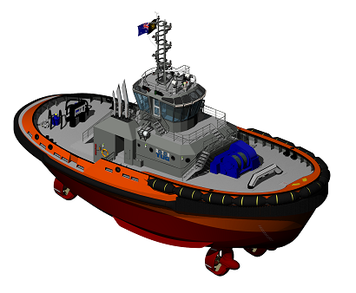Tractor tugs of all types arguably represent a bigger leap forward in utility than when the industry moved from single-screw to twin-screw tugs, or - before that - from steam to Diesel propulsion. They're that big a deal. The revolution has come over decades, but even in the sometimes slow-to-change maritime business this revolution is a fait accompli.
The "reverse tractor" or Azimuthing Stern Drive (ASD) Z-drive tug has become a North American staple; they're commonly seen now in most ports, even on the East Coast. They're massively useful in comparison to a traditional single- or twin-screw boat.
On the US West Coast, and in Alaska, Europe, Asia and other parts of the world, conventional tractors - the ones with the thrusters arranged at the bow of the tug - are common, with both Voith-Schneider and shrouded propeller Z-drive thrusters in use. The original "tractors" were of this design, using Voith-Schneiders. I had a friend who ran conventional tractors down in the Panama Canal Zone, and he liked them very much.
Voith-Schneiders (in his view, at any rate - I've never run one) are simpler to learn, coming very naturally to many operators. Thruster-equipped tugs are said to require more training. On the other hand, thruster-equipped boats generate more bollard pull than the Voith-Schneider boats from the same horsepower.
I'm used to the ASD type, having trained on them and run them during ship jobs from time to time.
But the Rotortug is an entirely different animal! I've been reading about these for several years, and the concept looks really interesting. But there's so much I don't know about them.
For instance, as an ASD driver I can see how the third thruster would enable you to do some additional things. But I wonder, how is the third unit operated? Both my hands are occupied when I'm running an ASD, so I'm not sure whether a Rotortug pilot presses his feet into service, or just operates the third thruster in a conventional way, taking one hand or another away from the twin controls when he needs to. I'd love to know!
On some of our tugs, foot pedals operate the forward line winch - so I could see thruster foot controls as a solution. Anybody know the answer to that?

Some of the ASD tugs I've trained on & operated were Robert Allan designs, using Ulstein units similar to those in the video, and they were very good tugs indeed - light and highly maneuverable, with excellent visibility.
And I've also run Schottel units in ASD configuration in a heavier, deeper, slightly less maneuverable Jenson design that, although a little slower, rode better in a sea and might have featured a little more bollard pull at the same horsepower. Both tugs were excellent shipdocking tools.
The three-thruster Rotortug design looks challenging to run (since I know nothing about how it's done). But I'm sure that the additional capability is controlled in such a way that it's not a problem. And once you've mastered it, I'll bet you can do some amazing things with it! I'd love to try one.
Do you have any experience with Rotortugs - especially with the control arrangement? Let us know about it by posting in the Comments section below!
 RSS Feed
RSS Feed